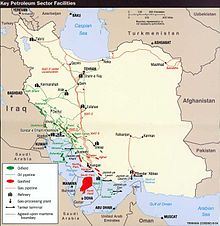
Back الطاقة في إيران Arabic انرژی در ایران Persian Energia Iranissa Finnish Énergie en Iran French အီရန်နိုင်ငံရှိ စွမ်းအင် Burmese Энергетика Ирана Russian 伊朗能源 Chinese
This article has multiple issues. Please help improve it or discuss these issues on the talk page. (Learn how and when to remove these template messages)
|


Iran possesses significant energy reserves, holding the position of the world's third-largest in proved oil reserves and the second-largest in natural gas reserves as of 2021. At the conclusion of the same year, Iran's share comprised 24% of the oil reserves in the Middle East and 12% of the worldwide total.[1]
In 2020, the Total Energy Supply (TES) in Iran was primarily sourced from oil and gas, with gas being the predominant contributor at 69% and oil at 29%. Nuclear power and renewable sources each accounted for 1% of the nation's TES.[2]
Iran also has the ability to generate significant power from renewable resources; due to the nation's closeness to the equator, 90% of its land area could provide solar power for at least 300 days a year.[3]
Oil in Iran is a major cause of air pollution[4] and greenhouse gas emissions.[5]
- ^ "International - U.S. Energy Information Administration (EIA)". www.eia.gov. Retrieved 2024-04-16.
- ^ "Energy Profile - Iran (Islamic Republic of)" (PDF). International Renewable Energy Agency (IRENA). 2023-08-08.
- ^ Cite error: The named reference
zawya.comwas invoked but never defined (see the help page). - ^ "Air Pollution In Iran Reaches Dangerous Levels As Dirty Fuel Is Used In Powerplants". Iran International. 2020-12-31. Retrieved 2021-07-10.
- ^ "Documents sent to UNFCCC by Iran". unfccc.int. Retrieved 2021-07-10.
© MMXXIII Rich X Search. We shall prevail. All rights reserved. Rich X Search